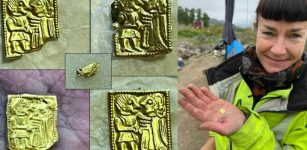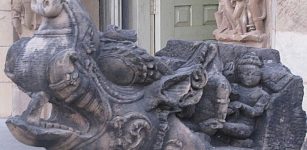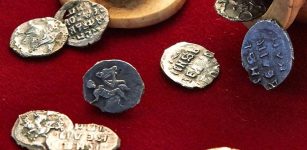Sampul Tapestry: Mysterious Silk Road Textile Linked To Hellenistic Kingdoms Of Central Asia And Tarim Basin
A. Sutherland - AncientPages.com - This tapestry was unearthed during excavations in 1983/84 at an ancient burial site in the Tarim Basin's oasis settlement of Sampul (or Shanpula) in western China.
The Tarim Basin - one of the most remote places on earth - is mostly covered by Taklamakan Desert, a mysterious, huge mass of sand with an area of 337,000 km2 (130,000 sq mi).
In Uigur language, ‘Takla Makan’ means ‘you can get into it but can never get out’ and that is why the desert is also called ‘the Sea of Death’.
Hazardous to cross and at the same time, very significant to the people in the region, the Taklamakan has many traces of the ancient civilizations. Many different people lived and passed through the Tarim Basin, before the Silk Road, and after its height.
This place is known of many archaeological treasures found in the Taklamakan’s sandy and forgotten ruins, especially - Tarim mummies, which date from 1800 BC to the first centuries BC.
See also:
Secret Ancient World Buried Under The Vast Takla Makan Desert
Lost Ancient Greco-Bactrian Kingdom Of 1,000 Cities
The Bayeux Tapestry: One Of The Great Historical Records Of The Middle Ages
Sampul Tapestry – a woolen 'wall hanging is made of 24 threads of various colors, and depicts a warrior and centaur - was discovered in a mass grave of the Sampul Cemetery, located east of the garrison town of Khotan.
Sampul is part of a gigantic concentration of ancient cemeteries extending over an area of 8 square miles.
Among the most important discoveries of this cemetery, there are two large shaft graves with the combined burials of 279 people, along with timber-built graves and boat-shaped coffins. Many bodies buried in the region look more Caucasian than oriental.
Additionally, archaeologists also found a tapestry that dates to the 3rd century BC to the 4th century CE) and is 48 cm wide and 230 cm long.
It depicts a warrior, who is believed to be a Greek soldier and the centaur in the background, is also a motif of Greek art.
The centaur fragment is 45 cm by 55 cm; warrior's face fragment is 48 cm by 52 cm.
The recovered tapestry only constitutes the left part of the decorative border of what would be a much bigger wall hanging.
The tapestry depicts a man with Caucasoid features, including blue eyes, and a centaur.
If lost fabric is accounted for, the soldier would be about six times as tall as the centaur.
The subject is identified as a warrior by the spear he is holding in his hand as well as a dagger tucked on his waist. He wears a tunic with rosette motifs. His headband could be a diadem, a symbol of kingship in the Hellenistic world – and represented on Greek and Macedonian coins. The centaur is playing a horn while wearing a cape and a hood. Surrounding him is a diamond-shaped floral ornament.
Interestingly, archaeologists unearthed the tapestry fashioned into a pair of man's trousers, while all the other trousers discovered in the Sampul cemetery had no decoration.
It is believed that the tapestry probably comes from the Greco-Bactrian Kingdom in Central Asia. The artifact is on permanent display in the Xinjiang Museum, Ürümqi, China.
Written by - A. Sutherland – AncientPages.com
Copyright © AncientPages.com All rights reserved. This material may not be published, broadcast, rewritten or redistributed in whole or part without the express written permission of AncientPages.com
More From Ancient Pages
-
 Why Were Viking Raids So Successful?
Ancient History Facts | Aug 3, 2016
Why Were Viking Raids So Successful?
Ancient History Facts | Aug 3, 2016 -
 Ancient Traditional Practices Can Help Europeans Adapt To Climate Change
Archaeology | Aug 31, 2022
Ancient Traditional Practices Can Help Europeans Adapt To Climate Change
Archaeology | Aug 31, 2022 -
 North America’s First Languages Originate From Siberia
Linguistic Discoveries | Apr 10, 2024
North America’s First Languages Originate From Siberia
Linguistic Discoveries | Apr 10, 2024 -
 Extraordinary Viking Boat Burial Of Two People Unearthed In Central Norway
Archaeology | Nov 20, 2019
Extraordinary Viking Boat Burial Of Two People Unearthed In Central Norway
Archaeology | Nov 20, 2019 -
 Ginnungagap From Which The World, Gods, Humanity And All Life Emerged In Norse Beliefs
Myths & Legends | Dec 11, 2024
Ginnungagap From Which The World, Gods, Humanity And All Life Emerged In Norse Beliefs
Myths & Legends | Dec 11, 2024 -
 Extraordinary Biblical Frescos Uncovered In Domitilla Catacombs
Archaeology | Jun 3, 2017
Extraordinary Biblical Frescos Uncovered In Domitilla Catacombs
Archaeology | Jun 3, 2017 -
 Dancing Around The Throne: Networking In The Time Of King William I
Ancient Traditions And Customs | Jul 4, 2023
Dancing Around The Throne: Networking In The Time Of King William I
Ancient Traditions And Customs | Jul 4, 2023 -
 Last Supper Of 15-Million-Year-Old Freshwater Fish
Paleontology | Mar 20, 2025
Last Supper Of 15-Million-Year-Old Freshwater Fish
Paleontology | Mar 20, 2025 -
 World’s Largest Complex Of Borobudur – Spectacular Buddhist Masterpiece
Civilizations | May 3, 2016
World’s Largest Complex Of Borobudur – Spectacular Buddhist Masterpiece
Civilizations | May 3, 2016 -
 Anqa: “Forgotten Twin” Of Dura-Europos Where Time Stood Still
Archaeology | May 9, 2024
Anqa: “Forgotten Twin” Of Dura-Europos Where Time Stood Still
Archaeology | May 9, 2024 -
 Mysterious Tiny 1,400-Year-Old Gold Foil Figures Found In Pagan Temple
Archaeology | Sep 23, 2023
Mysterious Tiny 1,400-Year-Old Gold Foil Figures Found In Pagan Temple
Archaeology | Sep 23, 2023 -
 Prophetic Dream Revealed Priceless Ancient Treasure That Was Later Stolen Or Destroyed – Was The Discovery Too Dangerous?
Ancient Mysteries | Jul 27, 2018
Prophetic Dream Revealed Priceless Ancient Treasure That Was Later Stolen Or Destroyed – Was The Discovery Too Dangerous?
Ancient Mysteries | Jul 27, 2018 -
 Makara – Legendary Sea-Creature With Many Incarnations In Hindu Mythology
Ancient Symbols | Feb 2, 2020
Makara – Legendary Sea-Creature With Many Incarnations In Hindu Mythology
Ancient Symbols | Feb 2, 2020 -
 Nazar Amulet – Blue Color Wards Off The Evil Eye According To Ancient Belief
Ancient Symbols | Mar 13, 2018
Nazar Amulet – Blue Color Wards Off The Evil Eye According To Ancient Belief
Ancient Symbols | Mar 13, 2018 -
 Znojmo Catacombs – Huge Underground Labyrinth Under A Medieval City
Featured Stories | Jan 17, 2016
Znojmo Catacombs – Huge Underground Labyrinth Under A Medieval City
Featured Stories | Jan 17, 2016 -
 Vikings’ Unicorn Bluff Fooled Europeans For Hundreds Of Years
Ancient History Facts | Apr 24, 2018
Vikings’ Unicorn Bluff Fooled Europeans For Hundreds Of Years
Ancient History Facts | Apr 24, 2018 -
 Sir Francis Walsingham: Spymaster, Politician And Trusted Adviser To Queen Elizabeth I
Featured Stories | Nov 25, 2019
Sir Francis Walsingham: Spymaster, Politician And Trusted Adviser To Queen Elizabeth I
Featured Stories | Nov 25, 2019 -
 Silver Coins Hidden In Chess Figure Date Back To Ivan The Terrible’s Days – Discovery In Moscow
Archaeology | May 13, 2017
Silver Coins Hidden In Chess Figure Date Back To Ivan The Terrible’s Days – Discovery In Moscow
Archaeology | May 13, 2017 -
 Five Ancient Mirror Frames, Ceramics Factory Found In Intriguing Roman Villa In Pavlikeni, Bulgaria
Archaeology | Mar 13, 2018
Five Ancient Mirror Frames, Ceramics Factory Found In Intriguing Roman Villa In Pavlikeni, Bulgaria
Archaeology | Mar 13, 2018 -
 How Did Alexander The Great Die?
Featured Stories | Apr 9, 2016
How Did Alexander The Great Die?
Featured Stories | Apr 9, 2016



